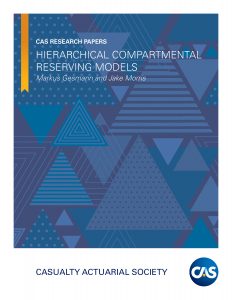
Why you should read the CAS research paper
Markus Gesmann and Jake Morris are delighted to present “Hierarchical Compartmental Reserving Models”, which was published as part of the CAS research papers series in 2020.
The paper demonstrates how one can describe the dynamics of claims processes with differential equations and probability distributions. All of this is embedded within a Bayesian framework that naturally facilitates the combination of judgement and historical data.
Unlike a ‘black-box’ technique this is very much a transparent framework, in which all assumptions can be reviewed and challenged. And unlike some of the traditional reserving methods that are often applied to data first and with judgement applied thereafter (shoot first, aim later), the approach encourages users to incorporate as much expertise into the model upfront and use the data to update input assumptions based on credibility (aim first, shoot later). This is particularly helpful when entering a new product, line of business, or geography or when changes to products and business processes would make past data a less credible predictor.
The document gives a hands-on introduction to hierarchical compartmental reserving models which complements mathematical notation with intuitive explanations. Real-world case studies (for which code is provided) can be replicated by the reader using the probabilistic programming language Stan via the brms package in R.
Four key takeaways from the research are:
- Thinking about the claims process as a ‘flow’ of monetary amounts from premium or exposure from one claims stage to another helps to describe the loss emergence process in a consistent way for different metrics of interest (Section 2).
- Modelling incremental claims payments may be preferred to cumulative data when working with lognormal distributions. Payments are incremental by nature and as cohorts of claims get more mature their payments typically get smaller and smaller, along with their variance. (Section 3.3).
- Hierarchical models provide an adaptive regularization framework in which the model learns how much weight subgroups of data should get, which can help to reduce overfitting. This is effectively a credibility weighting technique (Section 4.3).
- A distinction should be made between expected and ultimate loss ratios. The expected loss ratio describes the mean of a distribution assuming the process can be re-run again and again and is not anchored to the latest cumulative paid position. The ultimate loss ratio is the final actual loss ratio for a specific year, i.e., the latest cumulative paid position, plus all future payments. (Section 4.6).
“Hierarchical Compartmental Reserving Models” brings together ideas which the authors have written about, presented, and developed over a number of years, and therefore serves as a comprehensive resource for all those hoping to learn about the application of compartmental models to insurance reserving.
Authors:
Gesmann, M., and Morris, J. “Hierarchical Compartmental Reserving Models.” Casualty Actuarial Society, CAS Research Papers, 19 Aug. 2020, https://www.casact.org/sites/default/files/2021-02/compartmental-reserving-models-gesmannmorris0820.pdf


